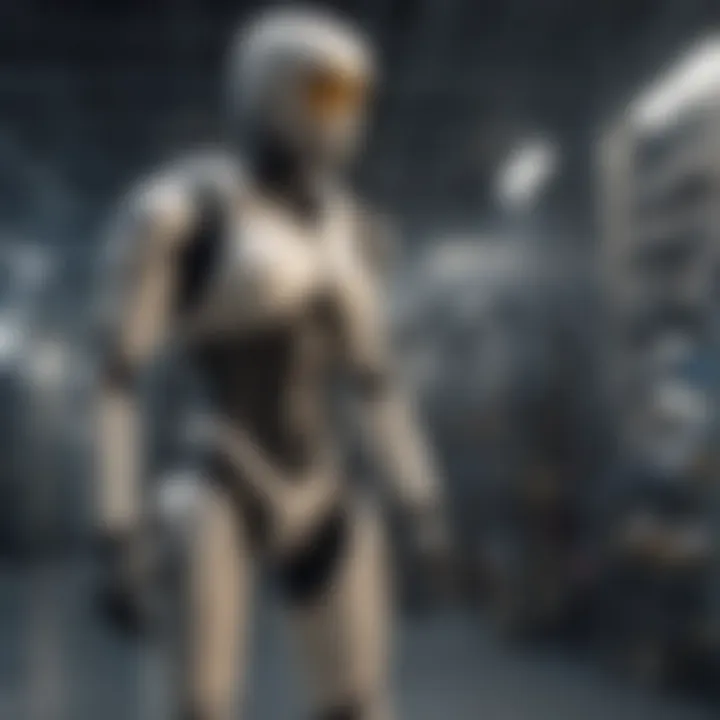Civilian Exoskeleton: Technology and Future Impact


Intro
The advent of civilian exoskeleton technology is reshaping the landscape of how we perceive human capability and mobility. These advanced devices, designed primarily for augmenting strength and endurance, are not just an imaginative concept found in science fiction but are tangible tools making waves in diverse sectors today. As populations age and industries seek to enhance efficiency, the relevance of exoskeletons has never been more pronounced. It’s an intersection of innovation, practicality, and ethical considerations that calls for in-depth exploration.
In this comprehensive analysis, we will dissect various facets of civilian exoskeletons, from the intricate engineering principles that underpin their design to the host of applications ranging from rehabilitation to labor-intensive work environments. The aim is to provide a clearer understanding of how these devices can significantly transform everyday life, allowing individuals to break through physical limitations and enhance their productivity.
Through exploring these topics, readers will gain insights into the pressing implications exoskeletons have on various fields. Whether it’s helping an elder regain mobility, assisting factory workers in lifting heavy loads, or even redefining how we approach tasks in agriculture, the impact of this technology resonates broadly. This analysis does not shy away from the ethical nuances, acknowledging what it means for workforce dynamics, and potential socio-economic disparities.
Ultimately, this analysis beckons readers to consider the future—how advancements in civilian exoskeleton technology may pave the way for a world where physical limitations are less of an obstacle. The turning point has arrived, and the discussions herein aim to illuminate the path ahead.
Foreword to Civilian Exoskeletons
The introduction of civilian exoskeletons marks a significant turning point in numerous fields, from rehabilitation to workforce enhancement. These innovative devices serve not just as passive aids but as active participants in the enhancement of human abilities. In an age where the demands of work and daily life are climbing higher, civilian exoskeletons present a fascinating intersection of technology and human capability, enabling individuals to achieve feats previously thought unattainable.
Definition and Purpose
Civilian exoskeletons, often referred to as wearable robotic suits, are designed to augment human strength, endurance, and mobility. While they may resemble sci-fi constructs, the purpose behind these devices is intricately linked to real-world applications. They can assist individuals recovering from injuries, help those with mobility challenges, and even improve productivity in industries demanding heavy labor. The core objective remains one of empowerment—assisting people in leading fulfilling, active lives despite any physical limitations.
For example, a construction worker wearing a civilian exoskeleton may find lifting and carrying heavy materials more manageable, thus improving their efficiency and reducing the risk of injury.
Historical Context
To fully appreciate civilian exoskeletons, a glance back at their history reveals a trajectory that began far from the civilian arena. Initial developments were rooted in military applications during the 1960s, focusing on enhancing soldiers' strength to carry heavier loads across rugged terrains. As advancements in technology emerged, the exploration of exoskeletons began to shift towards civilian use, particularly following the surge in interest during the early twenty-first century.
By the 1990s and early 2000s, projects aimed at rehabilitation gained traction. Researchers began to harness the principles of exoskeleton design to assist people with limited mobility, thus breaking into a wider market. This evolution showcases not only technological innovation but also a growing recognition of the value these devices hold in enhancing the quality of life for various populations.
"The road to advancement is paved with innovation, but every new tool has a story of its own that we, as a society, must understand."
In summary, the exploration of civilian exoskeletons is rooted in a blend of historical necessity and modern ingenuity. As we progress through the subsequent sections, the analysis will uncover how the engineering principles, applications, and implications of these remarkable devices can indeed reshape both everyday experiences and professional environments.
Engineering Principles of Exoskeleton Design
Understanding the engineering principles behind exoskeleton design is crucial for anyone involved in this field. It's not just a matter of putting together mechanical parts; it requires a comprehensive approach that balances functionality, user comfort, and practical applications. Much of the success of civilian exoskeletons hinges on how well these principles are executed. Innovations in this space can improve mobility for a variety of users, from those needing rehabilitation to workers in demanding jobs.
Mechanics of Movement
At the heart of exoskeleton design lies the mechanics of movement. The challenge is to replicate natural human motions while providing necessary support and enhancement. To achieve this, designers must understand biomechanics—the way our bodies move and how forces interact with muscles and joints.
Consider how a manual worker lifts heavy materials. An exoskeleton can be designed to multiply lifting power while reducing strain on the user’s back. For instance, a passive exoskeleton, which gives support through mechanical springs, works differently than an active one that uses battery-powered actuators to aid movement. Each type has its merits and drawbacks, but understanding which mechanics suit a specific situation is key.
"Effective movement mechanics can be the difference between a tool enhancing performance or causing injury."
Moreover, the integration of sensors that track motion and force dynamically can significantly enhance the user experience. By adjusting to how the user moves in real-time, exoskeletons can provide smoother and more natural support, thereby increasing efficiency.
Materials and Technologies
The choice of materials plays a pivotal role in the functionality and comfort of exoskeletons. Lightweight materials, such as carbon fiber, are becoming standard as they provide strength without adding excessive weight. The trick is to find a balance; an exoskeleton must be durable enough to handle the rigors of everyday use but light enough to allow for unobstructed movement.
In addition to traditional materials, advanced technologies have entered the fray. For instance, smart materials, which can respond to stimuli like pressure or temperature, are being explored. These can lead to breakthroughs in user interaction, allowing the exoskeleton to adapt to different tasks automatically.
Here are some important materials commonly used in exoskeleton construction:
- Aluminum Alloys: Offer a good strength-to-weight ratio.
- Composite Materials: Provide structural integrity with less weight.
- Sensors: Key for feedback, ranging from simple pressure sensors to complex gyros.
By selecting the right materials, not only can weight be managed, but overall performance can also be enhanced. This has a cascading effect on user acceptance and satisfaction.
Power Systems and Actuation


Powering an exoskeleton efficiently is a significant challenge that directly impacts its practicality. Current power systems range from traditional battery packs to pneumatic systems. Each comes with its own set of advantages and limitations.
Batteries, for instance, offer portability but can limit operational time. In contrast, pneumatic actuation can be powerful and responsive but may require bulky compressors and complex infrastructure. Therefore, the choice of actuation must consider both the context of usage and the desired functionality.
For example, a workplace exoskeleton designed for lifting tasks might prioritize high power output and quick response times, which can lean towards electric actuation. Meanwhile, a rehabilitation device might favor quieter and less intrusive options that can be discreetly managed.
Some common actuation systems include:
- Electric Motors: Often used in active exoskeletons for precision and control.
- Pneumatics: Provides robust power but can be more cumbersome.
- Hydraulics: Delivers high force but requires careful management of fluid dynamics.
Understanding these principles helps designers create exoskeletons that not only meet but exceed user expectations. In summary, the engineering behind civilian exoskeletons is multifaceted. Through a meticulous application of biomechanics, material science, and power management, these technologies stand poised to transform lives across various sectors.
Applications in Various Sectors
The landscape of civilian exoskeleton technology is not just a playground for engineers and scientists; it’s a shifting field applicable to a wide range of industries. Each sector echoes its unique requirements and challenges, which exoskeletons are designed to address, thus enhancing productivity, safety, and overall quality of life. Recognizing this diverse applicability underscores the importance of exploring the profound impact these devices may have across multiple domains.
Healthcare and Rehabilitation
In the healthcare sector, exoskeletons are reshaping rehabilitation practices, offering a lifeline to individuals recovering from injuries or facing chronic disabilities. These devices assist patients in regaining mobility, effectively bridging the gap between immobility and independence. For instance, robotic exoskeletons can accurately mirror the movements of the user, enabling physical therapists to conduct more effective rehabilitation sessions. They provide precise aid in walking, which promotes muscle memory and coordination, crucial for recovery processes.
Moreover, a significant benefit lies in the psychological aspect. The mere capability to stand or take steps can instill a newfound sense of confidence in patients, which is as pivotal as the physical recovery itself. It’s often quoted that ‘mind over matter’ plays a huge role in healing, and exoskeletons appear to boost this connection. By allowing individuals to participate in social interactions, they fundamentally change how rehabilitation is experienced, making it less isolating and more integrative.
Industrial and Labor Markets
Turning to industrial settings, exoskeletons are stepping onto factory floors and construction sites, helping to mitigate the physical toll these environments can extract from laborers. These devices are tailored to reduce strain, lift heavy objects, and support repetitive movements. Workers are less likely to suffer from musculoskeletal disorders, a prevalent issue in physically demanding jobs.
For instance, the construction industry can benefit immensely by integrating exoskeletons that help workers lift equipment or carry loads without the risk of injury. This not only leads to improved worker safety but also enhances productivity, as employees can perform their tasks with less fatigue.
As global industries push for more efficient operations while safeguarding employee well-being, exoskeletons represent a promising investment. They have the potential to reshape traditional labor dynamics and build a stronger workforce.
Aging Population and Assisted Mobility
As the demographic landscape evolves, with an increasing number of elderly individuals, exoskeletons offer remarkable possibilities for enhancing mobility and independence among this population. Standard wheelchairs can provide a means of transport, but exoskeletons allow seniors to regain a level of mobility they may have thought lost forever.
Through technology designed specifically for assisted living, elderly individuals can navigate spaces that may have otherwise been difficult, such as their own homes or community settings. This not only fosters a sense of autonomy but also encourages social participation, leading to a improved mental well-being. Imagine a grandmother being able to play with her grandchildren without limitations; this simple win can dramatically alter a family dynamic.
Military and Emergency Services
Finally, the military and emergency services realms are often the first to explore the frontier of exoskeleton technology. Here, the focus leans towards tactical advantages and enhanced endurance. Military personnel equipped with powered suits can carry heavier gear without the same level of fatigue, enabling them to cover greater distances, at times in hostile environments. These suits can also provide essential support during rescue operations, where every ounce of strength counts.
Imagine firefighters wearing exoskeletons designed to lift debris or carry additional equipment without taxing themselves. This could lead to efficient rescues and reduced injuries among first responders.
In summary, the potential applications of civilian exoskeletons span far and wide, addressing specific challenges within various sectors. From healthcare to labor markets, the aging population, and emergency services, these devices can remarkably enhance experiences and capabilities, paving the way for a future where mobility and independence are accessible to all.
Impact on Mobility and Quality of Life
The advent of civilian exoskeletons marks a watershed moment in enhancing not just physical movement but also the broader spectrum of life quality for users. Exoskeletons are designed to amplify human movement and strength, bridging the gap between disability and ability. Their profound impact reverberates through various aspects of daily life, offering a plethora of benefits, including the ability to regain autonomy and improve psychological well-being. Understanding these facets is crucial for grasping the full scope of the implications these technologies have on society.
Enhancing Physical Capabilities
At the heart of exoskeleton technology lies its primary function: the enhancement of physical capabilities. These wearable suits assist users in performing tasks that might otherwise be challenging or impossible due to physical limitations. For instance, individuals recovering from injuries or surgeries can benefit from using an exoskeleton to support their rehabilitation journey.
Consider the following points regarding the enhancement of physical abilities provided by exoskeletons:
- Joint Support: They provide structural support for joints, easing the strain while walking or lifting.
- Increased Endurance: Users can experience less fatigue during prolonged activities, extending their capabilities markedly.
- Improved Mobility: The devices can help individuals with mobility issues navigate their environments independently.
Imagine an elderly person who struggles with the burden of weak legs but can walk their dog again thanks to an exoskeleton. Such transformations highlight how mobility aids can reshape lives; it’s not just about moving from A to B but reclaiming a sense of independence.


Mental and Emotional Aspects
While the physical benefits of exoskeletons are apparent, the mental and emotional ramifications should not be overlooked. The ability to perform routine tasks or engage in social activities again can significantly boost a person's self-esteem and sense of identity. It’s akin to a long-lost memory being revived, bringing back feelings of normalcy and connection.
- Psychological Boost: Users often report an increase in confidence when they can participate in activities they once thought impossible.
- Social Interaction: Enhanced mobility encourages users to engage with friends and family more frequently, helping counter feelings of loneliness.
- Quality of Life: Overall well-being improves as users regain control over their lives, which can translate to a more positive outlook and better mental health.
"The ability to stand taller, move easier, and engage more fully with the world around us can transform the way we view our daily lives."
Case Studies and Real-World Applications
The transition from theory to practice can be best illustrated through real-world case studies. Many organizations are undertaking initiatives that employ exoskeleton technology with existing populations to illuminate their vast potential.
Some noteworthy examples include:
- Healthcare Rehabilitative Programs: Clinics have begun integrating exoskeletons into physical therapy regimens for stroke survivors, assisting in regaining lost mobility.
- Industrial Settings: Companies like Hyundai and Ekso Bionics have implemented exoskeletons for labor workers, reducing injuries and enhancing productivity on assembly lines.
- Home Use: Various user testimonials reveal how exoskeletons have facilitated everyday tasks like doing laundry or preparing meals, thus elevating the quality of life for many.
These cases not only showcase the viability of exoskeletons in real settings but also raise a broader question: How far can this technology go? Each success story paves the way for more comprehensive adoption and a deeper understanding of its capabilities.
Challenges and Limitations
In the realm of civilian exoskeletons, acknowledging the challenges and limitations is vital for a well-rounded analysis. The integration of these sophisticated devices into day-to-day settings presents various hurdles. These obstacles not only shape the design and functionality of exoskeletons but also influence their acceptance by users and society at large. By tackling the technical, financial, and human factors involved, we can gain insights into the complexities surrounding civilian exoskeleton technology, which can ultimately help in improving their practical application and acceptance.
Technical Barriers
The design of civilian exoskeletons is not as straightforward as one might assume. They must combine mechanical engineering, ergonomics, and a bit of robotics to function seamlessly with the human body. While innovations in materials and actuation systems have come a long way, several technical barriers remain.
For instance, achieving a balance between weight and functionality is quite a juggle. An overly heavy exoskeleton can hinder rather than help a user, making it challenging to wear for extended periods. Furthermore, the reliability of the actuators plays a crucial role—if they malfunction, the entire system can fail, potentially risking the user's safety.
"The road to a fully functional civilian exoskeleton is paved with engineering challenges, requiring creativity and precision."
Moreover, the integration of smart sensors and feedback systems adds complexity. These features need to be finely tuned to the user’s movement patterns to ensure that they feel natural. As a result, developing a truly intuitive interface that effectively communicates with the user is crucial but remains technically demanding.
Cost and Accessibility
When discussing the viability of exoskeletons, cost and accessibility surface as significant issues. The high price tag associated with advanced materials and robotics often limits availability to only those with substantial resources. This inherently creates a divide, reserving the benefits of this technology for a select few, which raises issues of equity in access.
Consider the financial logistics involved: research and development, manufacturing, and maintenance all contribute to the eventual cost. These factors need to be addressed not just from a technological standpoint but also from a business perspective. Manufacturers must find a way to reduce production costs without compromising quality, to make these devices accessible to more people.
In many sectors, particularly healthcare, limitations in budget can hinder the procurement of essential equipment, including rehabilitation exoskeletons. Until a more standardized and affordable model emerges, the potential of exoskeleton technology could be left untapped for many individuals who would benefit from it.
User Acceptance and Adaptation
Finally, one of the more nuanced challenges lies in user acceptance and adaptation. Integrating any new technology into daily life often met with skepticism, but in the case of exoskeletons, there are distinct psychological factors at play. Potential users must overcome a mental barrier associated with unfamiliarity and perhaps even fears about safety and efficacy.
Training users to operate these devices effectively is also essential. There’s not just a need for physical adaptation but also a mental shift required for one to confidently rely on this technology. Moreover, perceptions of exoskeletons might vary among different cultures or demographic groups, further complicating their acceptance.
The willingness of users to embrace this technology will significantly shape its future. As more people experience the benefits firsthand, there's a chance of greater acceptance, but the path to that share of mind might require extensive outreach and education about the advantages and functionalities of civilian exoskeletons.
Through exploration of these challenges, we gain a clearer understanding of both the obstacles faced in the current landscape and the potential methods to overcome them, leading to a more comprehensive future for civilian exoskeleton technology.
Ethical Considerations
As civilian exoskeleton technology continues its march forward, unraveling the potential benefits and applications, the ethical considerations surrounding its use are becoming ever more vital. People are increasingly using these technologies not just to enhance physical capabilities but also to improve the quality of life for various populations. Understanding the ethical dimension allows stakeholders— from designers and engineers to users and policymakers—to navigate complex issues, ensuring that advancements do not come at a social cost. Here, we will explore significant elements like privacy and surveillance, equitable access, and the potential impact on employment.
Privacy and Surveillance Issues
With the integration of advanced sensors and data collection capabilities, civilian exoskeletons stand at the crossroads of utility and privacy. These devices can collect information on a user's movements, health metrics, and even behavioral patterns. While such data can enhance performance and user experience, it raises uncomfortable questions about who controls this information and how it gets used. As we carve a path to a data-driven future, maintaining the balance between maximizing utility and upholding individual privacy must be paramount. Data breaches could expose users to unwanted scrutiny and exploitation, implying necessity for stringent regulations against misuse.


"As we delve into a new age of technology, how we protect the user's intimate data will define the pathway for citizen trust in these new tools."
Equity in Access
Another ethical aspect that requires attention is access to exoskeletons. Although these devices promise to enhance mobility and independence, such benefits need to be available to all, not just a select few. The high costs associated with development and production could make these exoskeletons accessible mainly to affluent individuals or organizations, leaving marginalized communities on the sidelines.
To address equity, measures must be taken to ensure that funding and resources are allocated effectively. Strategies can include government grants, insurance coverage updates, or non-profit initiatives to assist low-income populations. The goal should be to create a world where mobility-enhancing technology is a right, not a privilege.
Employment Implications
The rise of civilian exoskeletons poses complex implications for the job market. On one hand, these devices can empower workers in labor-intensive roles, making them more efficient and lowering the physical toll on their bodies. For instance, warehouse employees could use exoskeletons to lift heavier packages more safely, which is no small feat considering the injury rates in these sectors.
However, there's a flipside worth scrutinizing. Are we edging closer toward a future where human labor becomes redundant, replaced by machines and technology? This apprehension points to the need for careful planning and legislation to ensure human jobs remain intact, even as technology evolves.
In summary, ethical considerations in civilian exoskeleton development are multifaceted. Privacy issues necessitate vigilance against data misuse, while equity in access demands efforts to ensure everyone can benefit from these advancements. Finally, employment implications underscore a need for a balanced approach that empowers rather than replaces human labor. Gaining a firm grasp of these ethical challenges is essential for not only advancing technology but also building a society that values human potential alongside innovation.
Future Directions in Exoskeleton Development
The world of civilian exoskeleton technology is on the brink of significant breakthroughs. Understanding the future directions in this field is crucial, as it speaks to the shifting landscapes of healthcare, labor, and everyday life. With society's growing needs for enhanced mobility and efficient work processes, the refinements in exoskeleton technology are not just beneficial but rather imperative for individuals and organizations.
Innovative Research and Development
Exoskeletons are evolving rapidly, thanks to innovative research and development. Researchers across the globe are exploring myriad ways to make these devices more effective, efficient, and user-friendly.
- Adaptive Systems: One of the key areas of focus is the development of adaptive exoskeletons that can respond to the user's movements in real time. This type of technology aims to mimic natural human motion more accurately, reducing the mental load on the user.
- Wearable Sensors: Sensors integrated within these devices are being used to gather data on user movements, fatigue levels, and even environmental conditions. Such insights can help tailor the device operation to the user's specific needs and can improve overall safety.
- Sustainability: Another important angle of research is on materials that are lightweight yet durable. Biodegradable or recyclable materials are becoming a focal point, given the growing climate concerns. This can help align the technology with eco-friendly practices,
The development of these technologies will not only empower users but can also establish a more responsible approach to manufacturing and usage.
Integration with Robotics and AI
The melding of robotics and artificial intelligence with exoskeletons marks a new era of innovation. By harnessing AI, developers can enhance the functionality of exoskeletons in astounding ways:
- Smart Functionality: Imagine a smart exoskeleton that learns from the user's movements and grows more efficient over time. Such technology could adapt based on previous experiences, ultimately optimizing performance.
- Enhanced Decision Making: Integrating AI allows for real-time decision-making. In a scenario where a user encounters obstacles, an intelligent system could assess the best way to navigate them—think of it as a technological sidekick.
- Remote Control and Monitoring: Robotics combined with AI paves the way for remote control capabilities, allowing caregivers to assist users more effectively. This means maintaining a connection with healthcare professionals who can monitor users’ performance and provide real-time adjustments or solutions.
This integrated approach isn't just about enhancing user experience. It's also about transforming how we view assistance technologies in sectors like healthcare and manufacturing, making them more efficient and intuitive.
Policy and Regulatory Frameworks
As the technology advances, so too must the policies and regulations that govern it. Creating robust policy and regulatory frameworks is essential for navigating the complexities associated with exoskeleton technology. A few considerations include:
- Standards for Safety: Regulations should set clear safety standards to prevent potential injuries. This includes specifying operational limits and maintenance routines to ensure exoskeleton reliability.
- Ethical Guidelines: Policymakers need to consider the ethical implications around surveillance and data privacy that may arise from integrating sophisticated sensor technologies in exoskeletons.
- Accessibility Regulations: With the promise of improved mobility, regulations should also ensure that these technologies are accessible to all, regardless of socioeconomic status. This could involve providing incentives for companies that aim to develop affordable exoskeletons.
"Ultimately, the path towards effective regulations should involve collaboration among tech innovators, policymakers, and users to create an environment that fosters safe and equitable use of exoskeleton technology."
The forward-thinking approaches to policy will help create a safer, more inclusive future for civilian exoskeletons, thereby ensuring their prosperous integration into daily life.
Epilogue
The conclusion of this article serves as a vital thread tying together the numerous discussions surrounding civilian exoskeletons. While it’s easy to get lost in the technical jargon and the complexities of design and application, it is essential to step back and comprehend the larger implications of this evolving technology. The significance of exoskeletons lies not just in enhancing physical capabilities but also in broadening the horizons of what is achievable in various sectors including healthcare, industry, and even daily living for the elderly and disabled.
Summary of Key Insights
The synthesis of key insights has helped paint a clearer picture of the technological landscape surrounding exoskeletons:
- Rehabilitation Advances: Exoskeletons promote recovery for individuals with mobility impairments, showing marked improvements in patient rehabilitation outcomes.
- Industry Transformation: In labor-intensive sectors, these devices can alleviate physical strain on workers, thereby reducing errors and accidents.
- Aging Population: With an ever-increasing aging demographic, civilian exoskeletons can empower older adults, reclaiming independence that may have been compromised by physical limitations.
Considering the above points, exoskeletons offer a vision of a future where mobility and capability are not constrained by physical limitations but are instead augmented by technology.
Vision for Future Integration
Looking ahead, multiple pathways emerge for integrating exoskeletons into daily life. Some considerations include:
- Interdisciplinary Collaboration: By fostering collaboration among engineers, healthcare professionals, and policymakers, the development of exoskeletons can align more closely with the needs of various sectors.
- Technological Maturity: As materials and technology advance, we can expect exoskeletons to become lighter, more efficient, and easier to use, opening doors for broader adoption among the general public.
- Policy Frameworks: Establishing supportive regulations will be crucial to navigate ethical and privacy concerns associated with exoskeleton use, ensuring equitable access and accountability.















